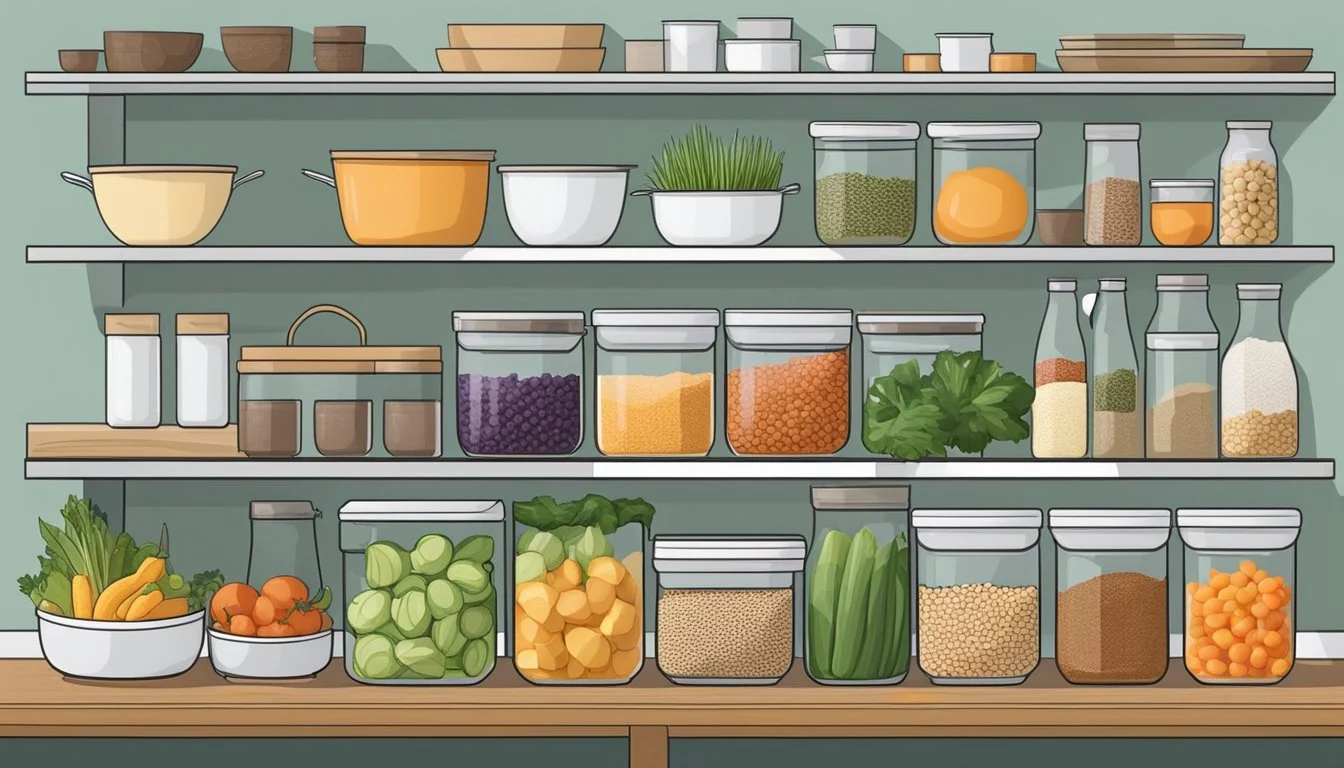The Ultimate Guide to Organizing Your Kitchen for a Specific Carbohydrate Diet
Streamlining Your Space for Health Success
Adopting the Specific Carbohydrate Diet (SCD) can be a transformative approach, especially for those managing conditions such as Crohn’s disease, celiac disease, or other forms of inflammatory bowel disease. This dietary strategy, pioneered by Elaine Gottschall and detailed in her book "Breaking the Vicious Cycle: Intestinal Health Through Diet," focuses on the consumption of monosaccharides—the simplest form of carbohydrates—and excludes complex carbohydrates like grains, starches, and sugars that can be difficult to digest. A critical element to successfully maintaining the SCD is organizing the kitchen to align with its guidelines.
Organizing one’s kitchen to support the SCD involves a meticulous approach to food selection and storage. It means ensuring that every item in one's pantry and refrigerator adheres to the diet's strict guidelines, which can be daunting at first. By categorizing foods into compliant and non-compliant, and redesigning the storage spaces to favor SCD-friendly foods, individuals can streamline their meal preparation processes. This not only aids in adhering to the diet with ease but also assists in preventing accidental consumption of foods that can exacerbate symptoms of inflammatory bowel disease.
Equipping the kitchen with the right tools and cooking utensils is similarly essential for those following the SCD. Cookware that best prepares simple carbohydrates, such as steamers for vegetables, and food processors for making SCD-legal flour alternatives, becomes fundamental. As individuals embark on this diet, the initial effort put into organizing the kitchen can pay dividends in fostering a sustainable and healthy relationship with food while managing digestive health concerns.
The Specific Carbohydrate Diet (SCD) Explained
The Specific Carbohydrate Diet, or SCD, is a stringent dietary approach created for individuals with certain digestive conditions that restrict carbohydrates to eliminate complex sugars and starches from the diet.
What is the SCD?
The Specific Carbohydrate Diet (SCD) is a nutritional regimen designed by Dr. Sidney Haas to primarily treat celiac disease, and later popularized by Elaine Gottschall. It restricts the intake of complex carbohydrates such as grains, sugars, and starches that are difficult to digest and may exacerbate gut symptoms. This diet is focused on removing foods that can fuel inflammation within the bowel, making it a subject of interest for people with various autoimmune and chronic digestive disorders.
Benefits of the SCD
The SCD is believed to provide several benefits, especially for individuals with digestive disorders like celiac disease, Crohn’s disease, and ulcerative colitis. By eliminating complex carbohydrates, the diet aims to reduce inflammation, improve gut health, and alleviate gut symptoms. Some people may experience improvements in energy levels and a stabilization of blood sugar. Furthermore, there is anecdotal evidence of the diet contributing to weight loss, though the primary goal is managing digestive health.
Key Foods in the SCD
Those following the SCD focus on consuming a range of nutrient-rich, unprocessed foods:
Fruits and Vegetables: Fresh and some cooked varieties that are low in complex carbohydrates.
Proteins: Unprocessed meats, fish, and eggs provide essential amino acids.
Nuts and Legumes: Select nuts and legumes that are SCD-compliant.
Dairy: Certain types of cheese, homemade yogurt that has been fermented for over 24 hours to reduce lactose content.
Natural Sweeteners: Honey is the preferred natural sweetener on the SCD.
Fats: Natural oils like olive oil are included for cooking and flavor.
Foods to Avoid
On the SCD, several food groups are strictly limited or excluded:
Grains: All grains, including wheat, rice, and corn, are to be avoided.
Sugars and Sweeteners: Most sugars, including sucrose and high-fructose corn syrup, are not allowed.
Processed Foods: This includes anything with additives or preservatives.
Starchy Foods: Starchy vegetables like potatoes, and products like pasta and bread, are eliminated.
Dairy: Milk and some cheeses, particularly those high in lactose, are excluded.
Planning Your SCD Kitchen
Properly setting up your kitchen is crucial for a successful Specific Carbohydrate Diet (SCD). Efficient kitchen organization facilitates easy access to SCD-friendly tools and ingredients, making SCD meal preparation a smoother process.
Essential SCD Kitchen Tools
The right tools are pivotal to adhere to the Specific Carbohydrate Diet. Key cookware and bakeware include:
Pots and pans: A set of high-quality stainless steel or cast iron pots and pans, avoiding non-stick coatings.
Cooking utensils: Wooden spoons, spatula, and stainless steel mixing bowls. Avoid plastic as it may not withstand high cooking temperatures.
Blender: A powerful blender to puree fruits, vegetables, and to create SCD-legal sauces and soups.
Baking sheets and dishes: Necessary for roasting vegetables and baking SCD-compliant breads and pastries.
Labeling cooking utensils can also help to prevent cross-contamination with non-SCD foods if necessary.
Creating an SCD Pantry
An organized pantry aids in maintaining the discipline needed for SCD. Consider:
Shelves: Assign each shelf for specific types of food, like one for nuts and another for permitted SCD dry goods. Label each shelf clearly.
Bins and containers: Use airtight containers to store nuts, homemade dry goods, and SCD-legal flours.
Labels: Clearly label each bin and container with the contents and the date stored to ensure freshness and compliance with the SCD.
Incorporating a space for vitamins and minerals, which are often a part of SCD, ensures they are easily accessible.
Refrigeration and Food Storage
Proper food storage in the refrigerator is essential for preserving the freshness of SCD ingredients. Organize the refrigerator using:
Drawers: Dedicate one drawer to leafy greens and another to fresh fruits. Label each drawer to maintain organization.
Baskets and containers: Use baskets for dairy products and containers for leftover meats and vegetables to prevent cross-contamination.
Refrigerator organization: Allocate specific areas for SCD-approved beverages and ready-to-eat snacks to make them easily accessible.
This structured approach to organizing cookware, pantry, and refrigeration promotes adherence to the Specific Carbohydrate Diet and streamlines the food preparation process.
Organizational Strategies for SCD Cooking
When preparing and cooking for the Specific Carbohydrate Diet (SCD), organizational strategies are crucial to maintain efficiency and ensure that the correct foods are ready to use. The following tips will streamline the preparation process and highlight time-saving cooking techniques suitable for the SCD.
Streamlining Food Preparation
One should organize the kitchen by grouping SCD-compliant utensils and cookware to maximize efficiency. Utensils like knives and cutting boards should be easily accessible. Pots and pans should be sorted by frequency of use, with those used most often in the front. For meal prep, mixing bowls and bakeware must be at hand for quick assembling of ingredients.
Pre-cut Vegetables: Store them in clear containers for easy identification and rapid use.
Label Containers: Use labels to identify foods and their preparation dates, to keep the freshest ingredients ready for cooking.
Time-Saving Cooking Techniques
Applying specific cooking techniques can significantly reduce the time spent in kitchen without sacrificing the quality or dietary compliance of SCD meals. Techniques like boiling, roasting, grilling, and steaming are all effective methods for preparing SCD-friendly foods quickly.
Batch Cooking: Cook large quantities of SCD-compliant ingredients, such as proteins and vegetables, to use throughout the week.
Cookware Arrangement: Place frequently used cookware like sauce pans or skillets nearest to the cooking station for easy access.
By employing these strategies, one can maintain an efficient kitchen setup that is conducive to the Specific Carbohydrate Diet, while also saving time during food preparation and cooking.
Maintaining an Organized SCD Kitchen
To successfully adhere to the Specific Carbohydrate Diet (SCD), maintaining an organized kitchen is essential. It streamlines meal preparation and minimizes the risk of dietary cross-contamination.
Daily Kitchen Routines
Implementing daily routines ensures that the kitchen remains conducive to the SCD lifestyle. Morning rituals should include washing dishes and wiping down countertops to prevent food buildup. In the evening, a quick sweep of the refrigerator helps monitor SCD-compliant ingredients and leftovers. Using drawer organizers and labels makes it easier to locate utensils and SCD-approved food items.
Morning Checklist:
Wash dishes and dry them before storing
Wipe down countertops and the sink
Evening Checklist:
Check refrigerator contents
Plan SCD meals for the next day
Decluttering and Minimizing
Minimizing clutter is paramount in an SCD kitchen. Start by decluttering cabinets and removing non-SCD items. Embrace simplicity and minimalism by keeping only essential kitchen tools and dishes. Transparent food storage containers help to quickly identify SCD-compliant foods, while decluttering the countertop of unnecessary items ensures a clean space for food preparation.
Cabinet Organization:
Keep only SCD-essential cookware and dishes
Use clear containers for easy identification
Handling Leftovers and Waste
Proper management of leftovers and waste is crucial to prevent clutter and maintain kitchen cleanliness. Store leftovers in clearly labeled containers in the refrigerator. Establish a routine for checking and using them promptly to avoid waste. Implement a composting system for organic scraps, and set up a designated area for recycling to handle non-organic waste efficiently. This not only helps with keeping the SCD kitchen organized but also contributes to environmental conservation.
Label and date all leftovers
Set up bins for composting and recycling
Additional SCD Resources
Embarking on the Specific Carbohydrate Diet (SCD) can be a transformative journey for those dealing with digestive disorders. It's essential for individuals to have access to reliable resources for recipes, support, and professional advice to ensure adherence and nutritional balance.
Cookbooks and Meal Plans
For newcomers and seasoned followers alike, SCD cookbooks and meal plans are valuable for easing the transition. They provide a structured approach to eating and help maintain variety in the diet. SCD cookbooks often come with detailed recipes that meet the diet's guidelines, while meal planning resources may offer weekly meal plans and shopping lists to simplify food preparation.
Some recognized books in this arena include:
"Recipes for the Specific Carbohydrate Diet" by Raman Prasad
"Cooking for the Specific Carbohydrate Diet" by Erica Kerwien
Online Communities and Support
The support found in online communities can make a significant difference in one's SCD journey. Various online forums and support groups provide a platform for individuals to share experiences, seek advice, and find encouragement.
Key online spaces include:
SCD Families Facebook Group: A place for families to discuss challenges and triumphs.
Nimbal.org: Offers educational information and community interaction under the PRODUCE section.
Professional Guidance
Ensuring accurate nutrition advice is critical for anyone on a restrictive diet, like the SCD. Engaging with registered dietitians or specialists well-versed in the SCD can help tailor the diet to individual needs to prevent malnutrition and promote overall health.
Individuals can seek out professionals through:
Local hospital nutrition departments
The official SCD websites, which may provide directories or links to specialist resources
Conclusion
Adhering to a Specific Carbohydrate Diet (SCD) requires diligence and a well-structured environment. Organizing the kitchen effectively plays a crucial role in maintaining this healthy lifestyle. By establishing distinct zones for cooking and food storage, individuals ensure that ingredients permitted on the SCD are at the forefront, minimizing the temptation of non-compliant foods.
A practical organization system they might implement includes:
Zone 1: SCD-friendly staples such as fruits, vegetables, and homemade yogurt.
Zone 2: Cooking implements like pots, pans, and utensils, easily accessible to prepare SCD-compliant meals.
Zone 3: Dedicated spaces for food preparation and storage containers to keep perishable items fresh.
Employing clear labeling on storage bins and pantry items facilitates quick identification and helps avoid accidental consumption of complex carbohydrates. Regular kitchen audits incentivize them to discard expired items and those no longer suitable for the diet.
They've learned that integrating the SCD into daily routines can be less overwhelming with an organized kitchen. This approach contributes to long-term success on the diet, as it simplifies meal planning and reduces cross-contamination risks. An orderly kitchen space is conducive to a stress-free cooking experience, allowing them to focus on the health benefits of their dietary choices.
In essence, the right organizational strategies lead to a supportive kitchen environment that upholds the principles of the Specific Carbohydrate Diet, bolstering their commitment to a healthy, balanced lifestyle.





